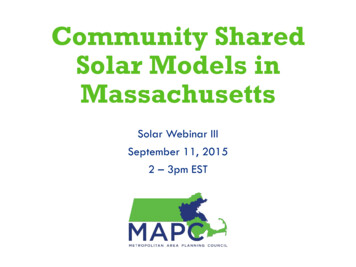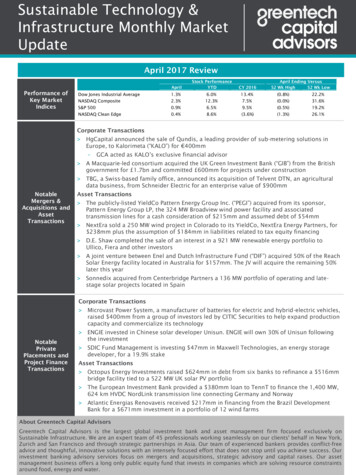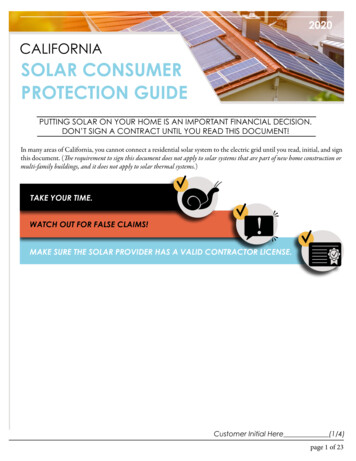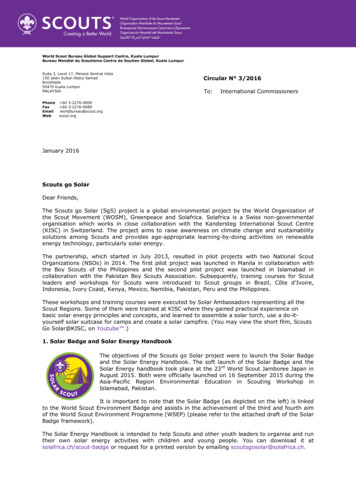
Transcription
Community SharedSolar Models inMassachusettsSolar Webinar IIISeptember 11, 20152 – 3pm EST
MAPC Solar Webinar Series Webinar I: Solar Permitting & Bylaws March 30, 2015; video recording (40 minutes). Webinar II: Solar Outreach Program Models June 2015; presentation slides. Webinar III: Community Shared Solar (CSS) Today; webinar will be recorded Webinar IV: Managing Solar Arrays September 30; details TBD.
Agenda1. Brief Introduction to MAPC Ani Krishnan2. Regulatory and Policy Context for CSS inMassachusetts Emma Krause, Department of Energy Resources (DOER)3. Commercial CSS Modelsa. Hannah Masterjohn, Clean Energy Collective (CEC)b. Lynn Benander, Co-op Power4. Q&A
MAPC: About UsMAPC is theregional planningagency serving the101 cities andtowns in theGreater BostonRegion.www.mapc.org
Clean Energy Division1. Regional Energy Projects ESCO Procurements Regional Solar Initiative LED Streetlight Purchasing & Retrofit Program2. Local Energy Action Program Community energy baselining Outreach, visioning, and program implementation Connection to utilities and incentives3. Energy Resources & Technical Assistance Community Electricity Aggregation (CEA)Resiliency and preparednessGreen Communities designation supportGrant writing & reportingClean Energy Toolkit
Creating A Cleaner Energy Future For the CommonwealthCommunity Shared SolarOpportunities inMassachusettsEmma Krause, Rooftop SolarChallenge Coordinator, DOER
MA CSS Policy – SREC’sMarket SectorA1.2.3.4.5.Generation Units with a capacity 25 kWSolar CanopiesEmergency Power Generation UnitsCommunity Shared Solar Generation UnitsLow or moderate income housing unitsSREC Factor1.0 RPS Solar Carve-Out Phase II program defines CSS projects as follows:Community Shared Solar Generation Unit. A solar photovoltaicGeneration Unit that provides net metering credits to three or moreutility accounts, whose participants have an interest in the productionof the Generation Unit or the entity that owns the Generation Unit, inthe form of formal ownership, a lease agreement, or a net meteringcontract. No more than two participants may receive net meteringcredits in excess of those produced annually by 25 kW of nameplate DCcapacity, and the combined share of said participants' capacity shall notexceed 50% of the total capacity of the Generation Unit.2Creating A Cleaner Energy Future For the Commonwealth
MA CSS Policy – Net Metering 3Net metering is an incentive program designed to encourage customers to installdistributed generation Customers offset own electricity usage Customers are compensated for electricity they generate and don’t use If consumption exceeds generation, customer pays for net kWh consumed If generation exceeds consumption, customer receives credit on bill for net excessgeneration Many non-residential and most municipal solar projects depend on the net meteringcredit incentive, along with SREC revenue MA market is non-uniform in the availability and value of net metering credits by utilityterritory Legislature raised net metering caps last summer Current net metering caps are set at 5% for public projects and 4% for private projects 17 member task force established by the legislature in 2014 Final report delivered to the legislature on May 1st The legislature currently has the net metering taskforce report and several bills beforeit to address the net metering cap issueCreating A Cleaner Energy Future For the Commonwealth
DOER Resources and Programs Green communities META grants for municipalities Mass Solar Loan program Roof top Solar Challenge RSC I - Portion of grant funding used to hire consultants todevelop a review and recommendations as well as animplementation guide for CSS /renewable-energy/solar/community-sharedsolar.html RSC II – 3 different municipal projects Green Communities CSS webinar /webinar-future-and-archive.html4Creating A Cleaner Energy Future For the Commonwealth
Thank YouEmma Krauseemma.krause@state.ma.us(617) 626 73715Creating A Cleaner Energy Future For the Commonwealth
��ts9/11/15SSss
CleanEnergyCollective CommunitysolarNation’s leading community solar provider Projects in 11 states with 25 utilities Built, own & operate 50 community solar facilities Community Solar Platform - Software as a Service tosupport utilities’ and developers’ programsFocused solely on community-owned solar Built the nation’s first and largest community-owned solar facilities More community solar built than all other vendors combined (60% of all systems) Worldwide recognition for having the best program availablePartners in local communities to provide utility and consumer value Worked with utilities from small rural cooperatives to nationwide IOUs CEC can fully fund, build, and administer projects – or provide tools Provide significant investment in the community and long-term local savings9/12/15 Copyright2015CleanEnergyCollective 2
Communitysolar oolYourneighbor’spanelsThe 996.6 kW Rehoboth, MA - Community Solar Array9/12/15 Copyright2015CleanEnergyCollective 3
LocalGov’tsasCustomersPurchase rights to bill credits Long term contractCash flow positive from Day 1 No upfront cost Monthly payments Monthly utility bill savings exceed monthlypayments (think 100k’s of savings)Developer assumes risk Responsible for maintaining project, ensuringproduction, you only pay for bill credits youalready receivedGet it while the getting’s good9/12/15 Copyright2015CleanEnergyCollective 4
LocalGov’tsasHostsHost project on local gov’t land Lease revenue Positive use for marginal/brownfield sitesLandfillsWater treatment plantsAirports Experience in working through FAA certification to build near small airportsAlways looking for similar sites Cheap land is key to community solar, and it provides a good way of flipping the narrative for asite that formerly caused negative impacts9/12/15 Copyright2015CleanEnergyCollective 5
LocalGov’tsasPartnersHelp market program Lend local gov’t credibility & channels to help marketcommunity solar programMaximize participation in Solarize programsDirect interested customers who can’t do rooftop docommunity solarValue in lead acquisition can discountInnovative planning/siting permitting Upfront coordination can result in lower cost, betterintegrated projectsExample: Fort Collins project on infill site – formerpickle factory. Municipal utility allowed extensivecoordination with planning and zoning committees9/12/15 Copyright2015CleanEnergyCollective 6
BenefitstoLocalGovernmentsRevenue Significant property tax revenue – often throughPILOTsPermitting feesJobs We partner with local contractors to build and maintainall our facilitiesCommunity Pride Affordable clean power is being generated right inyour community Participating customers, community members,school groups can all view projectSustainability & Environment Lower greenhouse gas emissions Cleaner air Far less water consumption than other energy sources9/12/15 Copyright2015CleanEnergyCollective 7
CommunitySolarPolicyLandscapeinMANeed to raise Net Metering caps for communitysolar projects to go forward Community shared solar is dependent on the mechanismof net metering to provide bill credits to participatingcustomersNet metering caps have been hit in National Gridterritory. Close to full in Nstar / Eversource territory.Senate has passed legislation to raise net metering capsGovernor has introduced legislation to raise net meteringcaps – H.3724House needs to pass legislation before Thanksgiving inorder to prevent significant disruption in state solarmarket9/12/15 Copyright2015CleanEnergyCollective 8
ts607- ‐431- ‐8811hannah.masterjohn@easycleanenergy.com
Community Shared Solar9.11.2015
Co-op Power is a network of local communitiesHampshireCommunityEnergy Co-opFranklinCommunityEnergy Co-opHampdenCommunityEnergy gy Co-opBlackstone ValleyCommunityEnergy Co-opBoston MetroEast CommunityEnergy Co-op
ACCOMPLISHMENTS22 Green Enterprises,200 Good Green Jobs anda growing multi-class,multi-race networkof 7,000 people acrossMassachusetts andVermont 2004: Co-op Power Community BasedBusiness Development Initiative launched 2005 to 2015: Six Solar Installation businessesstarted 2008: Co-op Power Solar Vendor Networkestablished (marketing for 15 installers) 2008: Co-op Power Solar Hot Water SystemInstallation Program launched ( 100 systemsinstalled) 2009: Green Job Training Program launched 2009: Co-op Power Member Loan Programlaunched ( 2 million) 2009: Co-op Power Residential EnergyEfficiency Business launched ( 1 million/year) 2009: Energía launched ( 3 million/yearenergy efficiency business in Holyoke)
ACCOMPLISHMENTS22 Green Enterprises,200 Good Green Jobs anda growing multi-class,multi-year networkof 7,000 people acrossMassachusetts andVermont 2010: Thermal window insert fabricationbusiness supported 2011: Two green electricians expansionsupported 2012: Co-op Power Boston Residential EnergyEfficiency Services launched ( 700,000/year) 2012: Brattleboro Food Co-op Solar SystemInstalled ( 30,000/year) 2013: Recycled Vegetable Oil Collection (250restaurants) 2015: Northeast Biodiesel ( 5.2 million/yearbiodiesel plant in Greenfield) 2015: Biodiesel Fuel Pump Station Networklaunched 2015: Community Shared Solar LLCs launchingnow
Sharing the SunWhat is Community Shared Solar?A solar-electric system that provides electricity (or virtualnet metering credits) to electric meters on more than onebuilding.
Community Shared SolarWhy is it useful for everybody?1)2)3)4)5)Reduces electricity costsEasier access to solarSmaller investmentEnvironmental peace of mindAvailable to everyone even if you don’t own ahome, don’t have a strong new roof, don’t haveenough sun, don’t have enough money, or can’t usethe tax credits
OpportunitiesTremendous Market InterestAttractive Government Incentives1)2)3)4)5)6)Solar Loan ProgramSolar Renewable Energy Credits (SRECs)Virtual Net Metering Credits (VNMCs)Power Purchase Agreement (PPA)Investment Tax Credit (ITC: 30%)5-Year MACRS DepreciationNational Solar Installation Costs DecreaseRising Electric Rates Making Solar More Competitive
Development Plan Plan: 10 projects beforeDec. 31, 2016 when ITClegislation expires 4 Site Visits & TechnicalReviews Completed 17 projects underdevelopment acrossMassachusetts andVermont with interestfrom other communitiesin New EnglandPipeline of CommunityShared Solar Projects
Community Shared Solar Overview# of ProjectsMW’sCostITC Investor EquityITC IRRLoans (SRECs)Loans (VNMCs)Sponsor Equity106 20 million 8.6 million10% 4.4 million 7 million 86,12342.5%22.1%35.0%0.4%
What We Need To Get There1. Community Partners2. Design/Build Contractors3. Financing4. Tax Equity Investors
Single Project BenefitsEliminateEnableProduce425 tons ofcarboneach year200-400families togo solar771,000KWh ofcleanelectricity
Benefits to ConsumersConsumers pay 2,000 for the Net Metering Credits generatedby 1 kilowatt of the array’s production for 25 yearsCo-op Power ModelOwning Your Own PV System 2.00 per watt 3.75 to 4.25 per wattIncludes payment for inverterreplacement Year 12Plus payment for inverterReplacement in Year 12Tax Credit and SREC’s are used to payother investors and lenders30% tax credit and SREC’s go to theHomeownerFor Renters and HomeownersFor HomeownersLocal Control and Local Ownership after5-7 yearsLocal Ownership and ControlBoth are likely eligible for the MA Solar Loan Program (3% or less interest; 10 years;20-30% reduction in cost for people who are 100% to 120% of the state’s medianincome.
Benefits to MunicipalitiesMunicipalities can sign up for as many kilowatts of production as youchoose for 2,000 for the Net Metering Credits generated by eachkilowatt of the array’s production for 25 years.Co-op Power ModelOwning Your Own PV System 2.00 per watt 2.75 to 3.25 per wattIncludes payment for inverterreplacement Year 12Plus payment for inverterReplacement in Year 12Tax Credit and SREC’s are used to payother investors and lendersSREC’s can go to the MunicipalityLocal Control and Local Ownershipof Project after 5-7 yearsLocal Ownership and Control of ProjectLocal Economic DevelopmentLocal Economic DevelopmentMunicipalities can lease land for use as a community shared solar site orsupport development of a community shared solar program to benefit peoplein their communities.
Project TimelineRaiseMoneyInstallations of SystemsEnvironmentaland PermittingReviewCommissionSystemsRequestNet MeterInstallationBuilding &ElectricalApplicationGuide &ReviewofSystemsInstallationof Net MeterProcure nd123456789101112End
Project 1: Greenfield Industrial ParkLocated on 23 acres ownedby Northeast Biodiesel600 kW generationNortheast Biodiesel will use200 kW200 households will use theother 400 kW – with 40% ofthose households beingfamilies on fuel assistancewith shares purchased withCAP agency grant funds
Solar LLC Funding Sources 1,000,000 852,616 900,000 702,154 800,000 700,000 442,773 600,000 500,000 400,000 300,000 8,612 200,000 100,000 Tax EquityInvestorsCo-op PowerInvestmentLoan FromBankCo-op PowerMembers
Solar LLC Start Up Costs 1,749,955 2,000,000 1,800,000 1,600,000 1,400,000 1,200,000 1,000,000 800,000 600,000 400,000 50,000 57,500 148,700 200,000 Solar Array Interconnection Legal ExpenseProjectManagement
ConclusionCo-op Power’s Community Shared Solar Is great for Consumers, especially people withLimited Resources Is a Successful Enterprise Is Good for the Environment Brings valuable Economic Benefits tocommunities across our regionCommunity Shared Solar needs your support in thelegislature. We need to raise Net Metering Capsand keep Virtual Net Metering.
Thank you for your time!Lynn Benander, President and CEO 413-5526446, lynn@cooppower.coop
Q&AAni KrishnanHannah MasterjohnEnergy PlannerMetropolitan Area Planning Councilakrishnan@mapc.org617-933-0715Director, Policy and New MarketsClean Energy -453-8924Emma KrauseLynn BenanderRooftop Solar ChallengeCoordinatorDepartment of Energy and Resourcesemma.krause@state.ma.us617-626-7371Chief Executive OfficerCo-op Powerlynn@cooppower.coop877-266-7543
Community Shared Solar Models in Massachusetts Solar Webinar III September 11, 2015 2 -3pm EST. MAPC Solar Webinar Series Webinar I: Solar Permitting & Bylaws March 30, 2015; video recording (40 minutes). Webinar II: Solar Outreach Program Models June 2015; presentation slides.










